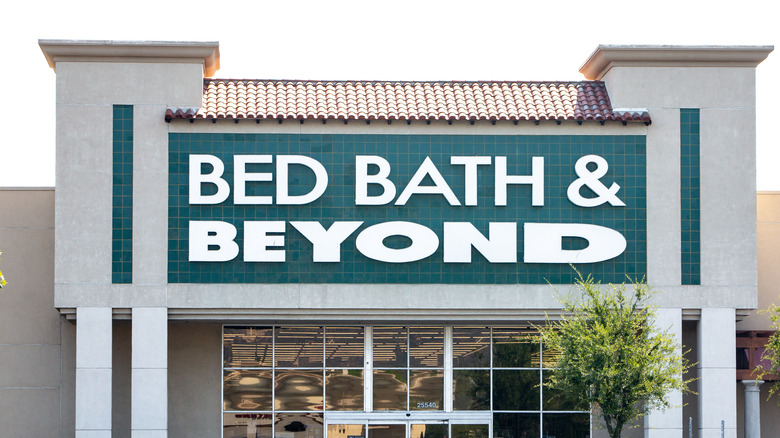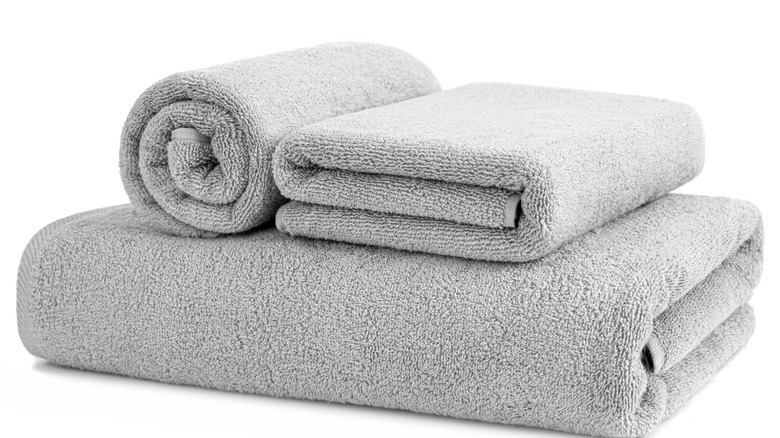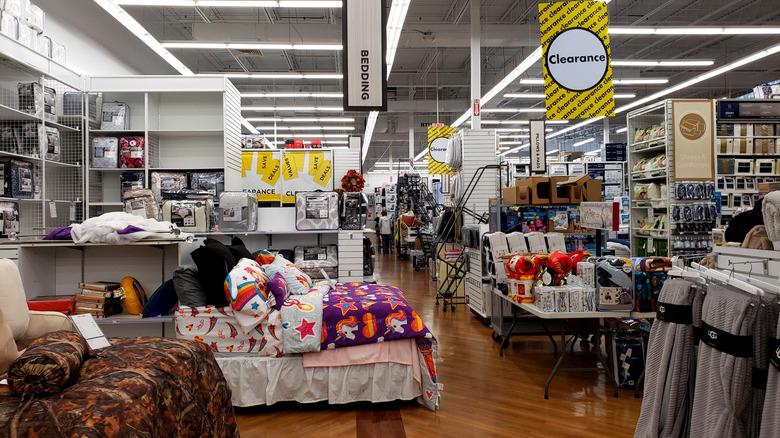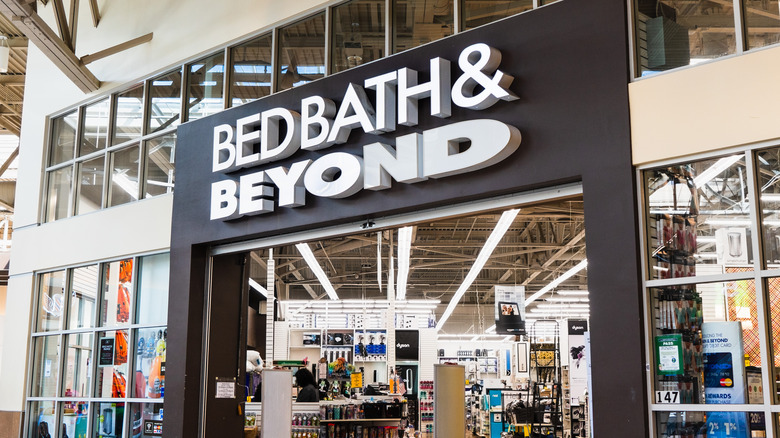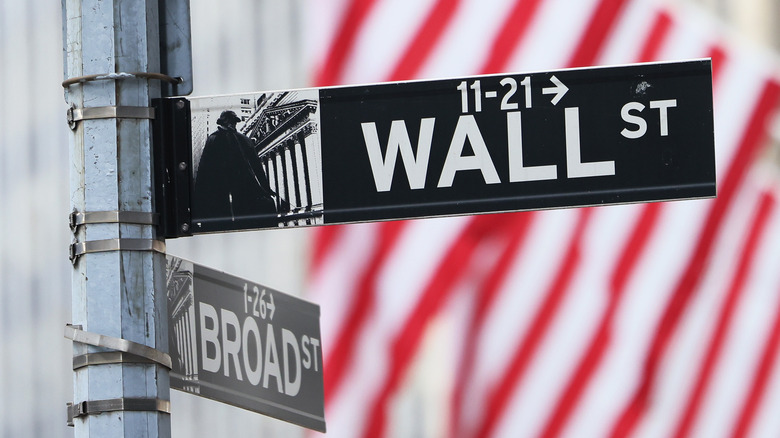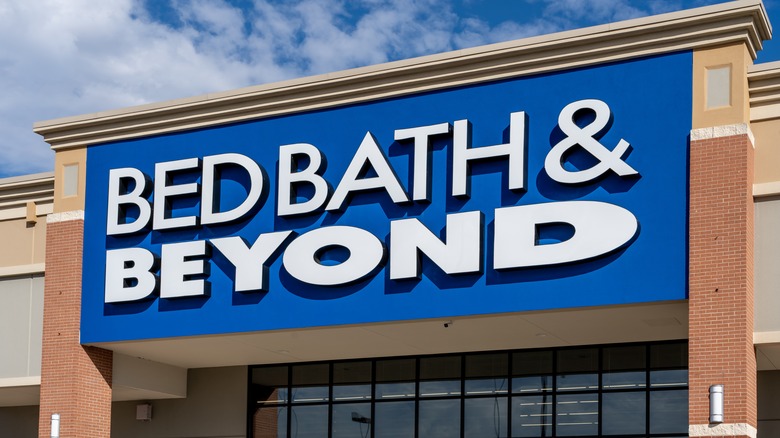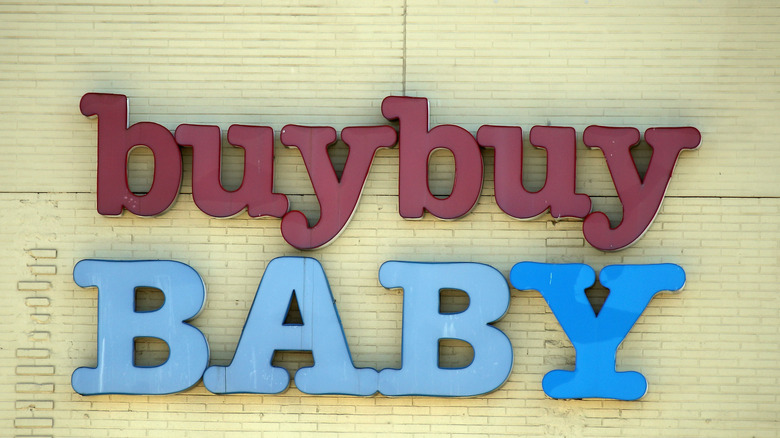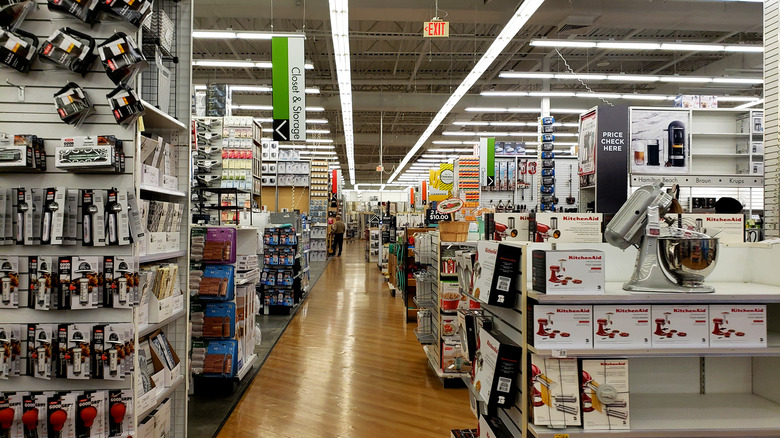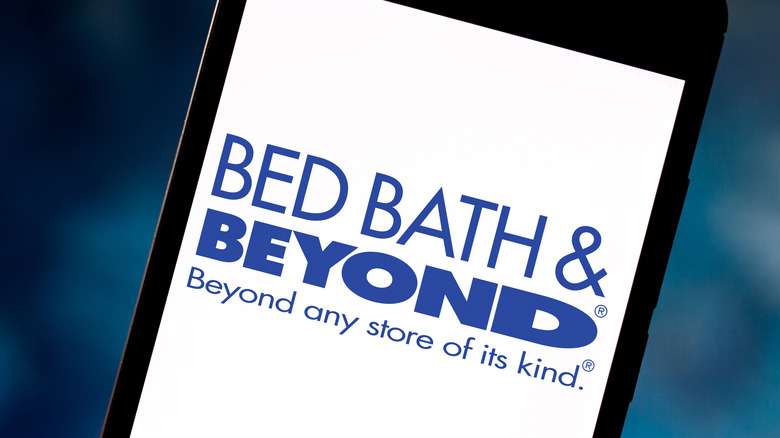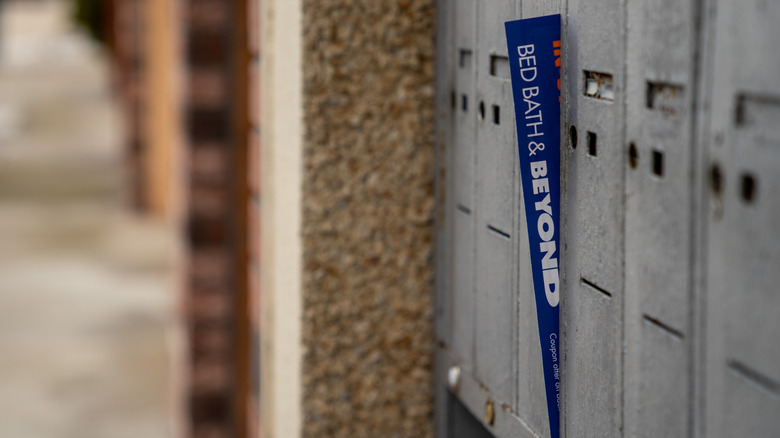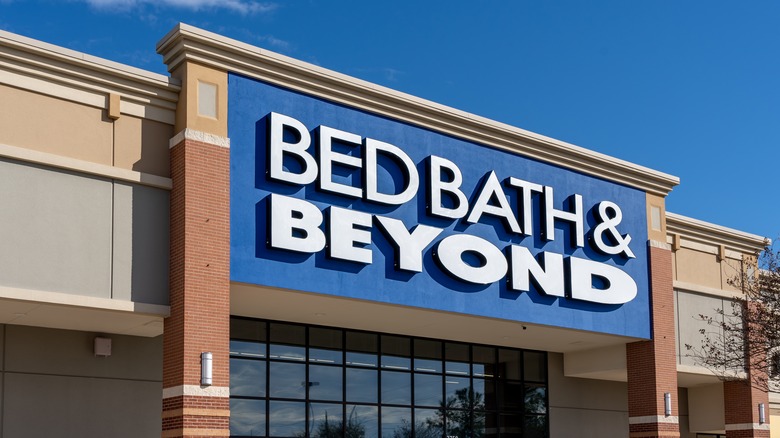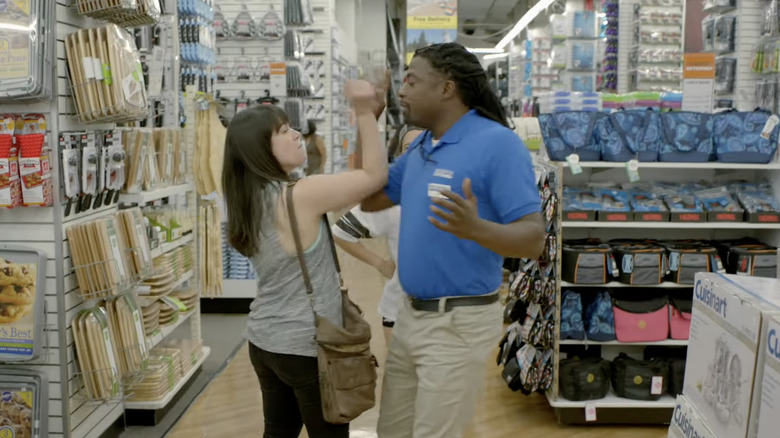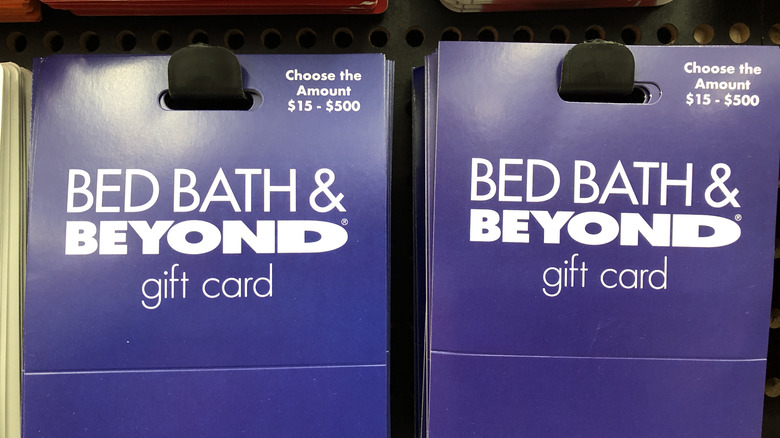The Untold Truth Of Bed Bath And Beyond
Overall, in-person retail was hurting well before the pandemic. According to CNN, large in-person department stores were the ones hurting the most financially. And now, things are even worse. The rise of online shopping has significantly changed the retail industry, and many businesses that thrived in years past have struggled to adapt. The COVID-19 pandemic was seen as the final nail in the coffin for the survival of department stores.
However, other outlets report that retail is simply reforming and that we shouldn't believe all the doom and gloom around the closure of brick-and-mortar stores. We are just simply in a transition period, and things will eventually iron themselves out (via The Hill). One such store caught in the crosshairs of this cultural movement is 1990s powerhouse Bed Bath and Beyond. Known for its "As Seen on TV" appliances, the neatly stacked towers of towels, and its lenient coupon policy, the retail giant holds plenty of untold truths.
There aren't actually stacks of towels in the store
Most of us likely have memories of roaming around Bed Bath and Beyond with our parents and being mesmerized by the sky-high stacks of towels displayed in the bath section. So, imagine our dismay when we found out that the towels aren't even towels at all. According to Consumerist, the clever marketing trick was exposed on Reddit. Instead of neatly folded towels, it's actually just stacks of foam with towel fabric attached to the front. "Busted! Yes, our little "secret" has been discovered. We do use a foam mold to keep our towel displays looking neat and clean for our customers," the chain's head of public relations told the magazine.
When you really think about it, it does make sense that there aren't actually stacks of real towels up there because they would easily get dirty. In addition, many of us might actually take relief in knowing that the displays are fake since we could never get our stacks at home to look as good.
Its original name was Bed `n Bath
When Bed Bath and Beyond first opened, it actually went by another name entirely: Bed `n Bath. According to Funding Universe, the name was changed as the store continued to expand. The first store opened in 1971 in New York and was the brainchild of co-founders Leonard Feinstein and Warren Eisenberg. They had over a decade of retail experience each at the time and wanted to try their hand at running their own business.
"'It was the beginning of the designer approach to linens and housewares, and we saw a real window of opportunity," said Feinstein. By 1985, the store had expanded to 17 stores across four states. The market wasn't so niche anymore as competitors were popping up on every corner. So, Feinstein and Eisenberg regrouped and rebranded to stay one step ahead by making things official and adding the "beyond" in 1987.
Managers worked the floor to build customer confidence
In the early days, shoppers at Bed Bath and Beyond never had to ask for a manager because there was always one around. According to Funding Universe, the reasoning behind this approach was to make shopping at the store an exciting experience for their main demographic: housewives. If they enjoyed their time at the store, they would return.
So, Bed Bath and Beyond was one of the first retail outlets to have both management and regular sales staff out roaming the floor to make themselves very visible to customers. This way, if guests needed any sort of assistance, there was always an employee nearby organizing a display or simply just stopping to check in on them. In addition to this, Bed Bath and Beyond was the first retail store to offer something that is now pretty common practice across the board: free delivery. If something was out of stock in-store, then customers could opt to have it shipped to their homes for free. This was a pretty novel concept at the time and really drove up the social currency of the brand.
The store was the darling of Wall Street in the 1990s
Bed Bath and Beyond had a very successful debut on the stock market. According to Funding Universe, it debuted on the NASDAQ exchange in June of 1992 for $17 per share. The stock was snapped up quickly and was very popular because the store received a lot of positive media attention at the time. The attention was only made greater when Bed Bath and Beyond opened a location in Manhattan.
By May of 1993, stock in Bed Bath and Beyond had almost doubled, as was trading at $32 a share, and the success didn't stop there. The Manhattan store is known for completely saving an area of town called The Ladies' Mile, which was filled with abandoned shops. Once Bed Bath and Beyond moved it, things started picking up, and within a year, Barnes & Noble, as well as Staples, had also moved into the area. This trend of Bed Bath and Beyond setting the tone for retail areas continued nationwide. But, the success wouldn't last.
Investors created a 168-slide presentation against senior leadership in 2019
Things haven't always been smooth sailing at the Bed Bath and Beyond corporate office as finances continued to tank even in the years before the COVID-19 pandemic. According to Reuters, investors were so unhappy with the way the company was being run that they put together a slide deck against the current management that can only be described as a total roast. It was 168 pages of scathing insults about the current leadership's management of the brand, finances, and more.
The concerned investors were Legion Partners Asset Management LLC, Macellum Advisors GP LLC, and Ancora Advisors LLC. Overall, the presentation served its intended purpose as CEO Steven Temares was replaced by Mark Tritton. In addition to this, the founders of the brand, Feinstein and Eisenberg, were also unceremoniously kicked off the Bed Bath and Beyond board of directors, effectively ending their working relationship with the company they founded in the 1970s.
Corporate often acquires the businesses of friends and family
High-level employees at Bed Bath and Beyond corporate have also come under fire for favoring friends and family members in business acquisition deals. These choices have caused many critics to accuse the company of nepotism. According to Forbes, Bed Bath and Beyond founders Warren Eisenberg and Leonard Feinstein's children have started companies that they have gone on to sell to their fathers for substantial profits.
For example, Buy Buy Baby was founded by two of Feinstein's sons, while Eisenberg's son founded another acquisition, Chef Central. It seems to critics at the company that the children are just creating companies knowing that their families will swoop in and purchase them at a substantial profit. However, the board hit back at these accusations, insisting that Bed Bath and Beyond purchasing these companies was good business sense and not just playing favorites. To justify this, they cited that the company also purchased eight other businesses that were not owned by family between 2002 and 2017.
The store acquired Buy Buy Baby to increase revenue, but might offload it
Another argument against Bed Bath and Beyond's alleged nepotism acquisitions is that as soon as the profits turn sour, the company is quick to leverage these deals to make a quick buck for the parent company. According to Bed Bath and Beyond Investor Relations, the company purchased Buy Buy Baby in 2007 as an all-cash deal for about 67 million dollars. At the time, Buy Buy Baby only had eight stores in New York, New Jersey, Maryland, and Virginia. However, since this original deal, the brand has expanded significantly. The deal was announced to much fanfare, and corporate expected the new brand to be a great fit.
However, since Bed Bath and Beyond has posted less than desirable profits in recent years and has been downsizing stores across the country, as of 2022 Buy Buy Baby is on the chopping block, but not for the reason you might think. The brand, unlike its parent company, is actually expanding. So, since Bed Bath and Beyond is in need of a cash infusion, this sale could be its saving grace (via Retail Dive).
Bed Bath and Beyond has a flexible return policy
Unlike most retail stores, you have more time to return items to Bed Bath and Beyond, regardless of whether or not you have a receipt with you. According to the store's website, you have 90 days to take home a product and decide if it works well for you. There are a few items that are exceptions to this, but the quickest turnaround on return time is 30 days for things like seasonal items (decorations, patio furniture, etc.), which is still very reasonable.
If you don't have your receipt, associates can typically locate your purchase in their point of sale system if you have the credit or debit card that you originally made the purchase on. If you purchased with cash, or they can't find your card in the system, you still might be in luck; you just will have to settle for merchandise credit instead of a refund, which, if you shop at the store often, is basically the same thing.
Cashiers used to accept expired coupons, but the practice itself may be expiring
It could be time to finally throw away the stack of store coupons you have at home. According to NorthJersey.com, shopping at Bed Bath and Beyond used to be a dream for people who loved to coupon. This is because the store used to accept their famous 20% off coupons, no matter what the expiration date actually said. This led to a common practice among shoppers who frequented the store of hoarding the bright blue slips of paper in their car, in the kitchen cabinets, or even on their foyer table under the guise of intending to use one each time they visited the store.
However, there are more and more anecdotal stories coming out of long-time shoppers being refused older coupons. This could be due to newer employee training as an attempt to drive up revenue. Another possible reason is that Bed Bath and Beyond has updated its point of sale systems, making the acceptance of older coupons impossible, no matter if the manager is willing to honor them or not. Either way, we will miss this practice but appreciate the extra room left in our homes once we've finally recycled those old coupon stacks.
More than 200 stores have been closed since 2020
COVID-19 and the ongoing push toward online shopping really hurt the store's business model. According to USA Today, the store announced plans to close at least 200 stores for good during the early days of the COVID-19 pandemic. These stores accounted for over 20% of the stores' total nationwide locations. These closures also come on the heels of the closure of 60 stores that was announced in October 2019. However, these drastic cost-cutting measures might be the only way to keep the one-time retail giant in business, as corporate reports that closing these stores will save the company between $250 and $350 million each year after the one-time costs of closing down.
The store closures are not concentrated in any one market and seem to be spread out evenly across the United States. The selection criteria for each store's closure were not made publicly available (via The Business Journals).
The store has a large place in American pop culture
There is just something so cinematic about Bed Bath and Beyond, as, according to the Product Placement Blog, the store shows up in "Bewitched," "The Other Guys," and even "Broad City." But in these scenes, it's not so much just a background for the action to occur, but the characters being in the store is a major plot point.
For example, in "Broad City," Ilana and Abbi take their time exploring their location and commenting on each of the items that are available to buy there. It seems like they aren't so much there for a specific item but rather just to enjoy the ambiance. This is made even more evident by an employee recognizing Abbi and performing a secret handshake with her (via Comedy Central). However, for older Millennials and members of Generation X, this experience tracks with Bed Bath and Beyond as a mecca for an enjoyable afternoon shopping in the 1990s and early 2000s.
Bed Bath and Beyond was often thought of as the place to shop for dorm decor
The chain values the dollars of college students and often markets directly to them. According to USA Today, Bed Bath and Beyond hosts a yearly summer sale exclusively for college students. Called the Summer Savings Pass, the program gives students the opportunity to save up to 20% off on all Bed Bath and Beyond purchases made from May through September. This gives students the perfect opportunity to top up on home decor, organizational items, and even small appliances for their dorms and apartments.
The only catch is that you will need to be actively enrolled in a program, so it won't work for recent graduates. Employees reserve the right to double-check your status through your student ID, student email address, or other means. This highly targeted marketing program is only a small part of a larger attempt to build brand loyalty young, as the store often posts blogs on its website with moving tips for college freshmen in an attempt to grab their attention (via Bed Bath and Beyond).
The store wants to be there for customers in every stage of life
Australian native Mark Tritton became CEO of Bed Bath and Beyond in 2019 and recognized that the store was struggling to maintain its business practices in an increasingly online economy. So, he unveiled a new corporate strategy at the NRF Retail Converge conference. The conference is an annual event hosted by the National Retail Foundation, a group dedicated to the success and innovation of retail stores and their employees.
According to NRF, Tritton asserted that his new idea for branding Bed Bath and Beyond is of a store that is there for you at every stage of your life. Whether you are moving into your dorm room and need the bare essentials, have finally purchased a new home, have had a baby, or even retired, he wants to make sure you can find exactly what you need in-store. It's his hope that being the one-stop-shop for all life's big changes can help to revive the brand and maintain repeat customers.
There's a store with the same name in New Zealand
If you ever travel to the land of "Lord of the Ring,s” you might notice that there is actually another Bed Bath and Beyond in New Zealand. According to the store's website, the chain began in 1995 and was originally called Linen for Less. The original idea was to sell overstock for just one bedding manufacturer in the largest city of Auckland. However, as the store's business grew, it went from just four stores in the Auckland area to over 50 across the entire nation.
The New Zealand version of Bed Bath and Beyond is currently the country's only linen specialist store. There is absolutely no corporate connection between the two stores, but the American company cannot sue for copyright infringements because they are overseas. If Bed Bath and Beyond USA wanted to expand into the New Zealand market, it might actually face copyright challenges since, technically, the other brand was established in the country first, and vice versa. But, so long as they operate in different economies, there is no direct competition and, therefore, no lawsuit (via Bradley).
